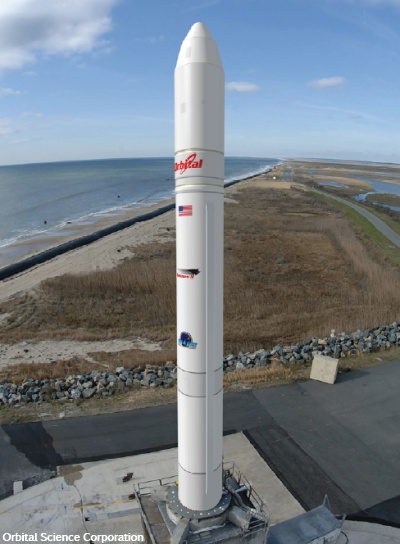Orbital Sciences is an established space company primarily known for their Pegasus small satellite launcher which is launched under the wing if a mother aircraft like SS1/SS2 or the X-15.
Below are the first photos their latest effort; the Cygnus ISS cargo hauler engineering sample which is to be launched by a new booster, the Taurus II.
The Cygnus spacecraft, shown here at last weeks National Space Symposium in Colorado Springs, Colorado, is to haul what cargo the SpaceX Dragon doesn't and could, like Dragon, be modified for crew flights - though with more effort since Dragon was designed for the dual role from the get-go.
Unlike Dragon, Cygnus has no ability to return cargo or experiments to Earth (down-mass capability) - it's a one way ticket up - and ,making it a manned spacecraft will require much of it, the forward 2/3 or so, to be redesigned.
Taurus II is interesting because it uses a liquid first stage powered by two Aerojet AJ-26 engines which are derived from Russian Kuznetsov NK-33's. The NK-33's were derived from the NK-15 engines used in their mighty N-1 moon rocket.
The Taurus II's second stage uses a solid fuel Castor 30, but there is an optional methane/LOX version for heavier payloads. The third stage is actually the Cygnus's service module and it uses hypergolic fuels (ignite on contact).
Taurus II should get its first flight test from NASA's Wallups Island, Virginia Flight Center sometime in mid to late 2011 with Cygnus flying sometime later.
I'm also including links to PDF guides for both the Cygnus and the Taurus II, though the latter is large. very detailed and meant for potential launch customers.
Cygnus PDF.....
Taurus II User's Manual PDF (9+ megs)....
Cygnus - service module (rear third)

Cygnus - ISS docking port (front)

Taurus II + Cygnus

Below are the first photos their latest effort; the Cygnus ISS cargo hauler engineering sample which is to be launched by a new booster, the Taurus II.
The Cygnus spacecraft, shown here at last weeks National Space Symposium in Colorado Springs, Colorado, is to haul what cargo the SpaceX Dragon doesn't and could, like Dragon, be modified for crew flights - though with more effort since Dragon was designed for the dual role from the get-go.
Unlike Dragon, Cygnus has no ability to return cargo or experiments to Earth (down-mass capability) - it's a one way ticket up - and ,making it a manned spacecraft will require much of it, the forward 2/3 or so, to be redesigned.
Taurus II is interesting because it uses a liquid first stage powered by two Aerojet AJ-26 engines which are derived from Russian Kuznetsov NK-33's. The NK-33's were derived from the NK-15 engines used in their mighty N-1 moon rocket.
The Taurus II's second stage uses a solid fuel Castor 30, but there is an optional methane/LOX version for heavier payloads. The third stage is actually the Cygnus's service module and it uses hypergolic fuels (ignite on contact).
Taurus II should get its first flight test from NASA's Wallups Island, Virginia Flight Center sometime in mid to late 2011 with Cygnus flying sometime later.
I'm also including links to PDF guides for both the Cygnus and the Taurus II, though the latter is large. very detailed and meant for potential launch customers.
Cygnus PDF.....
Taurus II User's Manual PDF (9+ megs)....
Cygnus - service module (rear third)

Cygnus - ISS docking port (front)

Taurus II + Cygnus

